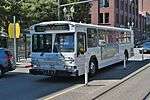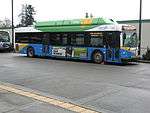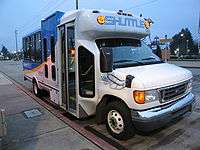Pierce Transit
Pierce Transit, officially the Pierce County Public Transportation Benefit Area Corporation, is an operator of public transit in Pierce County, Washington. It operates a variety of services, including fixed-route buses, dial-a-ride transportation, vanpool and ride-matching for carpools. The agency's service area covers the urbanized portions of Pierce County, part of the Seattle metropolitan area, and includes the city of Tacoma.
 A compressed natural gas bus operated by Pierce Transit | |
| Founded | 1979 |
|---|---|
| Headquarters | 3701 96th Street Southwest Lakewood, Washington |
| Locale | Pierce County, Washington |
| Service type | Bus, vanpool, paratransit |
| Fleet | 155 buses |
| Annual ridership | 9,104,337 (2015) |
| Fuel type | Diesel, compressed natural gas |
| Chief executive | Sue Dreier |
| Website | www |
History
Public transportation in Pierce County historically focused on the city of Tacoma, which laid its first streetcar lines in 1888. The streetcars were phased out in the 1930s and replaced with citywide bus service, with the last line closing in 1938.[1] The operators of the streetcar and bus systems, Tacoma Transit Company, was acquired by the city government in 1961 for $750,000. Under city ownership, the system was funded by a $0.75 monthly household tax first levied in 1965.[2]
A public transportation benefit area (PTBA) was created in 1979 with the goal of establishing a countywide bus system. On November 6, 1979, voters in Tacoma approved a 0.3 percent sales tax to fund a new transit system, the Pierce County Transportation Benefit Area or "Pierce Transit". Pierce Transit took over Tacoma Transit's routes on January 1, 1980, and over the following year annexed other systems throughout the county.[2]
Pierce Transit began operating express bus service from Lakewood and Tacoma to Downtown Seattle on September 17, 1990.[3] The routes were later converted into Sound Transit Express routes, funded by the regional transit authority and operated by Pierce Transit, in 1999.[4] The agency opened its central bus hub at Tacoma Dome Station in 1997, where Sounder commuter rail and Tacoma Link light rail service began operating in 2000 and 2003, respectively.[5][6]
The passage of Initiative 695 in 1999 eliminated the use of motor vehicle excise tax, a funding source for local transit throughout the state, leading to service cuts at Pierce Transit despite it later being ruled unconstitutional by the Washington Supreme Court. In 2000, 14 percent of service was reduced and a fare increase was set to temporarily make up for revenue from the tax, which made up 38 percent of the agency's operating budget. Voters approved a 0.3 percent sales tax increase to fund transit service during a special election in February 2002,[7] preventing a planned cut in bus service of up to 45 percent, and up to 25 percent for paratransit.[8][9]
Funding crisis
In 2012, Pierce Transit argued that it was in an unsustainable state due to its reserves running out, and as a result, must cut service by 53% in order to become sustainable again. Pierce Transit argued that if taxes within its service area were increased by 0.3%, Pierce Transit would not have had to cut service, and instead could have improved service by 23%.[10] Opponents of the 0.3% tax increase in Pierce County (also known as Proposition 1) advertised a sales tax increase to 10.1% (the "highest on the West Coast"), but in reality that rate would have only applied to motor vehicles due to the state motor vehicle sales and use tax.[11] Most taxable goods and services would have been taxed at the rate of 9.8%. Pierce Transit proposed a similar increase in sales tax in 2011, which was eventually rejected by the public.[12] Proposition 1, proposed in the 2012 general election, has also been rejected by the public.[13]
In May 2012, the cities of Bonney Lake, Buckley, DuPont, Orting, and Sumner withdrew from the boundaries of Pierce Transit's service area, which shrunk to 292 square miles (760 km2).[14]
Bus rapid transit service
Pierce Transit plans to build a bus rapid transit system on Pacific Avenue between Tacoma and Spanaway, replacing a 14.4-mile (23.2 km) section of Route 1. The $150 million project, partially funded by Sound Transit 3 and the federal government, is scheduled to begin construction in 2020 and open in 2022.[15] The bus rapid transit line is planned to use curb-side and median stations, with 3.6 miles (5.8 km) of dedicated bus lanes and 32 total stations.[16]
Administration
Pierce Transit is operated by nine-member Board of Commissioners composed of elected officials throughout the county. The Board of Commissioners operates under a Chief Executive Officer, Sue Drier.[17] A staff of approximately 1,000 man the five departments, with over 50% working in Transit Operations.
Police
Pierce Transit contracts with the Pierce County Sheriff's Department for police services. There are currently 16 patrol deputies assigned full-time to Pierce Transit. The command staff of Pierce Transit Police include two Supervising Sergeants and the Transit Police Chief(provided by the Pierce County Sheriff's Department - under contract). The Pierce Transit system is also patrolled by 17 specially commissioned Peace Officers (Public Safety Officers).
Services
As of 2012, Pierce Transit served a 292-square-mile (760 km2) area with a population of approximately 557,000.[14] Areas served include Auburn, Edgewood, Federal Way, Fife, Fircrest, Gig Harbor, Joint Base Lewis–McChord, Lakewood, Milton, Pacific, Purdy, Puyallup, Ruston, South Hill, Steilacoom, Tacoma and University Place.
In 2008, 19 million people utilized its services. 272 wheelchair-accessible buses circulate between 3,300 bus stops, 626 bus shelters and 28 park-and-ride lots. Additionally, Pierce Transit runs 11 transit centers and stations. Pierce Transit also provides vanpool, ridematching and express transportation between counties. Disabled passengers who are not able to use Pierce Transit's buses have access to a special transportation system called SHUTTLE.
Bus routes
| Route # | Route Name | Notes | Continues as |
|---|---|---|---|
| 1 | 6th Ave–Pacific Ave | ||
| 2 | S 19th St–Bridgeport Way | ||
| 3 | Lakewood–Tacoma | ||
| 4 | Lakewood–South Hill | ||
| 10 | Pearl St | ||
| 11 | Point Defiance | 41 | |
| 13 | N 30th St | Monday–Friday only | |
| 16 | North End | 48 | |
| 28 | S 12th St | ||
| 41 | S 56th St–Salishan | 11 | |
| 42 | McKinley Ave | ||
| 45 | Yakima | ||
| 48 | Sheridan–M St | 16 | |
| 52 | Fircrest–TCC | ||
| 53 | University Place | 55 | |
| 54 | 38th St–Portland Ave | ||
| 55 | Tacoma Mall | 53 | |
| 57 | Union–S 19th St–Hilltop | ||
| 63 | NE Tacoma Express | Weekday, peak-hours only | |
| 100 | Gig Harbor | ||
| 102 | Gig Harbor Express | Weekday, peak-hours only | |
| 202 | 72nd St | 409 | |
| 206 | Pacific Hwy–Tillicum | ||
| 212 | Steilacoom | 214 | |
| 214 | Washington | 212 | |
| 400 | Puyallup–Downtown Tacoma | Monday–Friday only | |
| 402 | Meridian | ||
| 409 | Puyallup–72nd St TC | 202 | |
| 425 | Puyallup Connector | Monday–Saturday only | |
| 497 | Lakeland Hills Express | Weekday, peak-hours only | |
| 500 | Federal Way | ||
| 501 | Milton–Federal Way |
Fares
| Service | Adult | Youth/Senior/Disabled |
|---|---|---|
| Local | $2 | $1 |
| Pierce Transit Local 24-Hour Pass | $5 | $2.50 |
| Pierce Transit Local Monthly Pass | $72 | $36 |
| Summer Youth Pass | - | $36 (Youth only) |
- Under 6 ride free with a fare-paying rider; limit is 3.
- Passengers aged 6 to 18 pay youth fare.
- Summer Youth Pass only valid on Pierce Transit from June to August.
- Passengers 19 to 64 pay adult fare unless they have a valid regional reduced fare permit.
Fares last updated on: 3/1/2016 [18]
Facilities
Transit Centers
- 512 Park and Ride
- 72nd St Transit Center
- 10th and Commerce (Downtown Tacoma)
- Lakewood Transit Center
- Lakewood Sounder Station
- Parkland Transit Center
- South Hill Mall Transit Center
- Tacoma Dome Station
- Tacoma Mall Transit Center
- TCC Transit Center
Fleet
In 1986, Pierce Transit began experimenting with compressed natural gas as a fuel source for its bus fleet by modifying two existing buses, becoming the first agency in the nation to do so.[19] As of 2018, 118 of the 153 buses in the agency's fleet run on compressed natural gas. Other models are diesel–electric hybrids or use electric batteries.[20]
Bus
| Manufacturer | Model | Year | Fleet Numbers |
Qty. | Length | Fuel Type | Notes | Image |
|---|---|---|---|---|---|---|---|---|
| Gillig | Phantom 40' | 1999 | 8018–8069 | 23 | 40 ft (12 m) | Diesel |
|
 |
| Low Floor CNG (G27D102N4) | 2015 | 251–260 | 10 | CNG |  | |||
| 2016 | 261–270 | 10 | ||||||
| Low Floor CNG (G31D102N4) | 2017 | 271–277 | 7 | |||||
| Low Floor HEV 40' (G30D102N4) | 2010 | 501–509 | 9 | Hybrid Electric | .jpg) | |||
| 2013 | 510–515 | 6 | ||||||
| 2014 | 516–521 | 6 | ||||||
| Low Floor CNG (G31D102N4) | 2018 | 10101–10123 | 23 | CNG |  | |||
| 2019 | 10124–10143 | 20 | ||||||
| Chance | AH-28 Streetcar | 2000 | 330–332 | 3 | 28 ft (8.5 m) | Diesel |
|
.jpg) |
| New Flyer | C40LF | 2002 | 167–184 | 18 | 40 ft (12 m) | CNG | .jpg) | |
| 2004 | 185–204 | 20 | ||||||
| 2005 | 205–229 | 25 | ||||||
| C40LFR | 2007 | 230–239 | 10 |  | ||||
| 2008 | 240–250 | 11 | ||||||
| C30LF | 2004 | 305–319 | 8 | 30 ft (9.1 m) |
|
 | ||
| 311–317 | 7 | |||||||
| Proterra | Catalyst E2 | 2018 | 522–524 | 3 | 40 ft (12 m) | Battery Electric | .jpg) |
Shuttle/Bus Plus
| Make | Model | Purchased | Retired | Qty. | Fleet Numbers | Fuel Type | |
|---|---|---|---|---|---|---|---|
.jpg) | Ford E450 | ElDorado Aerotech | 2004 | retired | 49 | 5001-5049 | |
 | Ford E450 | ElDorado Aerotech | 2005 | 30 | 5801-5809, 5050-5070 | ||
| Ford E450 | ? | 2006 | 5 | 5071-5075 | |||
 | Ford E450 | ElDorado Aerotech | 2007 | 5810-5819, 5076-5100 | |||
| Ford E450 | ElDorado Aerotech | 2012 | in service | 38 | 5101-5138 | Unleaded | |
| 2014 | 18 | 5149-5160, 5165-5170 | |||||
| 2014 | 10 | 5139-5148 | CNG | ||||
| 2016 | 30 | 5171-5200 | Unleaded |
Vanpool
| Make | Model | Year | Retired | Qty. | Fleet Numbers |
|---|---|---|---|---|---|
| Ford | E350 | 2002 | retired | 1 | 4116 |
| 2003 | 24 | 4140, 4143, 4144, 4146-4148, 4151-4153, 4155, 4157, 4158, 4160, 4161, 4163-4165, 4167-4171, 4176, 4179 | |||
| 2006 | most retired | 67 | 7095-7161 | ||
| E350XL | 2005 | retired | 48 | 7014-7061 | |
| 2008 | partially retired | 23 | 7226-7248 | ||
| 2013 | in service | 19 | 7342-7360 | ||
| E450 | 2005 | 2 | 5800, 5811 | ||
| Transit Connect | 2016 | 21 | 7404-7424 | ||
| Chevrolet | Astro | 200X | retired | 12 | 4122, 4123, 4127, 4129-4136, 4139 |
| Express Van | 2007 | 56 | 7162-7217 | ||
| 2008 | mostly retired | 15 | 7218-7225, 7249-7255 | ||
| 2010 | in service | 66 | 7256-7321 | ||
| 2012 | 20 | 7322-7341 | |||
| 2014 | 28 | 7361-7366, 7373-7394 | |||
| Express 3500 | 2016 | 60 | 7473-7532 | ||
| 2017-2018 | 62 | 7546-7607 | |||
| Dodge | Grand Caravan | 2005 | retired | 14 | 7000-7013 |
| 2015 | in service | 9 | 7395-7403 | ||
| 2017 | 13 | 7533-7545 | |||
| Caravan | 2018 | 8 | 7608-7615 | ||
| 2019 | 10 | 7625-7634 | |||
| Chrysler | Pacifica | 2019 | 8 | 7616-7623 |
Ferry
- Steilacoom-Anderson Island Ferry
Adjoining transit agencies
References
- Malloy, Dick; Ott, John S. (1993). The Tacoma Public Utility Story: The First 100 Years, 1893–1993. Tacoma Public Utilities. OCLC 29528435.
- Public Transportation Office (October 1984). "Local Transit". Public Transportation in Washington State (PDF) (Report). Washington State Department of Transportation. pp. 105–106. OCLC 13007541. Retrieved September 10, 2016 – via National Transportation Library.
- Shatzkin, Kate (September 17, 1990). "Commuters happy to let others do driving: Tacoma-to-Seattle bus has a successful start". The Seattle Times. p. D1. Retrieved September 11, 2016.
- Whitely, Peyton (September 17, 1999). "Buses ready to roll". The Seattle Times. p. B1. Retrieved September 11, 2016.
- Kaiman, Beth (September 12, 2000). "Commuter rail service to begin; New trains will run between Tacoma and Seattle". The Seattle Times. p. B1.
- Lindblom, Mike (August 23, 2003). "Sound Transit starts small with Tacoma Link system". The Seattle Times. p. B1. Retrieved September 15, 2016.
- Corvin, Aaron (February 6, 2002). "Pierce County voters approve sales-tax increase for transit agency". The News Tribune. p. 1.
- "Pierce Transit approves request for sales tax request on 2002 ballot". Tacoma Daily Index. December 5, 2001. Retrieved September 15, 2016.
- Corvin, Aaron (January 28, 2002). "Future of Tacoma bus system riding on levy". The News Tribune. p. 1.
- http://www.piercetransit.org/prop1/
- http://dor.wa.gov/content/FindTaxesAndRates/OtherTaxes/tax_motorvehicle.aspx
- http://www.thenewstribune.com/2011/01/23/1513538/crisis-point-for-pierce-transit.html
- http://blogs.seattleweekly.com/dailyweekly/2012/11/pierce_transit_prop_1_fails_defated_bus_cuts_pierce_county_transportation_tacoma.php
- "Summer 2012 Report to the Community" (PDF). Pierce Transit. June 2012. Archived from the original (PDF) on September 15, 2012. Retrieved April 20, 2018.
- Ruud, Candice (April 6, 2018). "Wave as they pass your car. Fast buses could be coming to a long stretch of Pacific Avenue". The News Tribune. Retrieved April 6, 2018.
- Sailor, Craig (April 10, 2019). "Pierce Transit board chooses middle-of-the-road solution for $150 million bus project". The News Tribune. Retrieved April 16, 2019.
- "Pierce County Public Transportation Benefit Area Corporation". Archived from the original on 2009-07-15. Retrieved 2009-07-23.
- http://www.piercetransit.org/PT-fares
- Wald, Matthew L. (April 7, 1989). "Alternative-Fuel Vehicles Move From Fancy to Fact". The New York Times. Retrieved September 11, 2016.
- Cohen, Josh (October 11, 2018). "How an explosion in Canada threatened to stop buses in Pierce County". Crosscut.com. Retrieved November 12, 2018.
- "Appendix D – Inventories". 2019-2024 Transit Development Plan (Report). Pierce Transit. 2019. pp. D1–D37. Retrieved June 22, 2020.
- "Pierce Transit". Canadian Public Transit Discussion Board. Retrieved June 22, 2020.